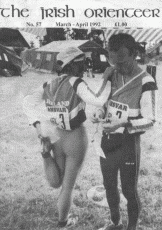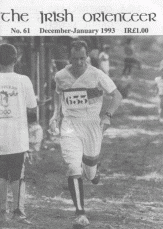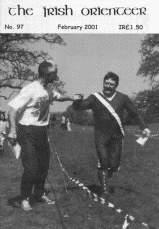The Rocket
| December, 2001 | Editor: Eoin Dunne | Newsletter No. 34 |
TIO goes for the ton!
Early next year should see a milestone in orienteering as "The Irish Orienteer" reaches its centenary issue. This venerable publication has been the sole source of orienteering news for many years and I for one was unaware of anyone other then John McCullough being responsible until an e-mail appeared in the orienteering e-mail group. On further investigation, I found that Barry Walsh did the first issue whereupon Brendan McGrath took over the reins for two years. One of Brendan's recollections was the time he was cutting and pasting an article together (using scissors and glue, not Microsoft Office) and then decided to remove the body of the text leaving the first and last lines. This prompted a comment from one of the mountaineering magazines that the article resembled "a telegram from a down-and-out in the bush in Australia." I'm not sure if editorial control changed at that point but another 3ROC member, Susan Cawley, took over for a while until the TIO found its way into the hands of the present editor, John McC. However, the TIO has not been without controversy as John seems to have invoked the wrath of all of Connacht at one stage or another with his "robust" reviews of various Connacht Champs. On other occasions he's been accused of being biased towards 3ROC. Still, we're fortunate to have someone as determined as John to keep the show on the road. Well done John and long may it last.
 |  |  |
Waiting for the sh** to hit the fan!
(Planner's report - Three Rock Wood, Nov 4th, 2001)
This was how Deputy Chairman Brendan McGrath eloquently described the situation at our recent event up in Three Rock Wood. To put things into context, Brendan was acting as Controller and was on standby waiting for any news of missing controls so that he could tear off with a spare control and punch to right any wrong. Thankfully, as the day wore on, no problems were reported. One group of finishers bitterly complained that a control below the masts was missing thus causing some concern. However, a subsequent finisher confirmed that it was still there and a lively debate ensued. Meanwhile, back at the start area, an unexpectedly large number of students and scouts had caused a backlog on the Light Green course. This was eventually remedied by adding an additional master map and most people didn't mind the wait. However, one person who is well known in hill-running circles decided he wasn't going to wait and skipped the queue. On finishing, he proceeded to bore the arse off anyone who would listen about the poor organisation. If he doesn't come back I don't think I'll be too upset. As for the planning, well that was my area of responsibility and as it was the first League event I had planned, I was anxious to get feedback. I think most people were happy though some felt the Light Green and Green courses to be too easy. These are probably the hardest courses to plan as they attract people with all levels of experience and so I tended to cater more for the novices. All in all, things worked well and credit must go to Monica Nowlan who organised things with a precision that the Marines would admire and also to Brendan McGrath who demonstrated patience worthy of Job while he waited for me to produce some sort of event. Thanks also to all members who helped with the event. It wouldn't have happened without you.
Eoin.
Results round-up!
3ROC was well represented at the recent Munster and Connacht Champs with several members achieving fame and everlasting glory. Well done to the following:
Munster - Monica Nowlan (1st) W50, Claire Walsh (2nd) W55, Vera Murtagh (2nd) W60, Una May (2nd) W21L, Ger Power (3rd) W50, Justin May (3rd) M21L, John McCullough (3rd) M45, Brendan McGrath (3rd) M50, Nigel Campbell-Crawford (3rd) M55
Connacht - Gary Tully (1st) M21S, Brendan McGrath (1st) W35?? (the things people will do to win!), Frank Martindale (2nd) M60, Vera Murtagh (2nd) W60, Monica Nowlan (3rd) W50
Well done to all the other people who took part, I hope you enjoyed your runs.
Club shorts
A very warm welcome to the following new members: Emma McAuley, Paul and Anne-Marie Kennedy, Siobhán Cottell, Barbara and Alan Horner, Gary Tully. I hope you will all thoroughly enjoy the "cunning running". Also, a reminder to anyone who has joined 3ROC since last September that you need not worry about subs until 2003.
On behalf of all members, I'd like to wish a speedy recovery to Eoghan O'Suilleabhain who injured his leg and had to be carried of the mountain at the recent Munster Champs. Let's hope he'll be out and about in no time at all.
Congratulations to Justin May on his appointment to the IOA executive as Director of High Performance. Well done also to Brendan Cryan who retains his position as Development Officer.
Several orienteers turned out for the launch of Sean Rothery's book "A Long Walk and A High Life" at the Tara Hotel last November. The sub-title is "From the North Sea to the Alps - a journey through time and space" and should appeal to all armchair explorers out there.
A provisional date has been set for the AGM for February 22nd (after the Pine Forest event). It is hoped to expand on the social aspect of this important event so watch this space for details.
Don't forget, training is ongoing under the expert instruction of Lindie Naughton on the following evenings: Tuesdays and Thursdays: Merrion Cricket Club, Anglesea Road, Ballsbridge (just opposite the junction with Simmonscourt Road) from 6.30pm onwards. Wednesdays: Sion Hill gym, Mount Merrion Avenue. If coming from Blackrock, the entrance is on the right just before the traffic lights at Cross Avenue. Circuit training starts at 6.50pm sharp
Three Rock before 3ROC!
Recently while browsing the Internet, I found a reprint of a book entitled "The Neighbourhood of Dublin" by Weston St. John Joyce (third and enlarged edition 1920). The author provides a fascinating snapshot of the suburbs and outskirts of the city and it was interesting to see what has changed and what hasn't. I've extracted an abridged version for your enjoyment and if it proves popular, I'll include the remainder of the chapter in the next Rocket.
At this point we turn to the left along a road which gradually ascends for about three-quarters of a mile to Tiknock crossroads, from which on a clear day, an extensive view is obtained to the north and east. We here turn to the right along the Tiknock road, with heather and gorse-clad heights on either side. A few hundred yards further on, a cottage will be seen in the fields to the right, behind which is the once famous Grumley's Well, where a patron was formerly held, and where even now an occasional pilgrim comes to pay his devotions. A remarkable head of water originates at this well which forms the source of a pretty stream flowing through the fields and crossing the road from Harold's Grange. As we continue our journey, the view extends eastward, and we presently obtain a view of Kingstown and its harbour, after which we cross a spur of the Three Rock Mountain by a steep ascent, where the road is very rough and loose in consequence of being torn up by the torrents in rainy weather. To the right will be seen a precipitous rocky eminence rising over the group of cottages known as Stackstown, to which there is a pathway through the fields from the road. Just as this steep part of the road is passed, and we again reach level ground, a lane, entered by an iron gate, will be seen on the left - follow this lane past the farmhouse, and pass trough the latched wooden gate at the end beside the rifle club house, after which bear well to the left - in a south-easterly direction - over rocks, gorse, and heather, resplendent with colour in blossoming time, until at length the tops of the rocks are seen peeping above the sky-line in front. A wire fence will then be observed, with a conspicuous stile for the convenience of visitors. The three groups of rocks which give name to this mountain are nearly in a line, running south-east by east, and are only partially visible from the Dublin plain. The following scientific description of them, by Mr. G. V. Du Noyer, an eminent archaeologist and painter, is taken from a memoir published in 1835 by the Geological Society of Ireland, to explain their map of the Dublin district: - "The remarkable-looking bosses of granite on the summits of the Three Rock and Two Rock Mountains are not perched blocks, but the solid granite weathering in places; and this weathering is solely the result of long-continued atmospheric action - rain, frost, and snow. The rock being evenly jointed in vertical as well as horizontal planes, has weathered on the line of separation; and some of the rough cubical masses thus formed have resisted the action of the weather more completely than the others. In this way are left those great table-like masses, having their edges moulded along the horizontal joints."
A much more fanciful description is that of Gabriel Beranger, who wrote about 1780: - "This mountain has on its summit three huge heaps of rock, piled one on another, and seen at some miles distance, from which the mountain takes its name. I take them to be altars on which sacrifices were offered. The plate represents one of the most entire; it rises about 18 feet above the ground, and is accessible by an easy ascent. It has several basins cut in the rock on its top, of the size of the inside of a man's hat; but one more remarkable than the rest, being of an oval form, and measures 2 feet 6 inches in length by 2 feet broad, the depth in the centre, 9 inches. Another of these, but less entire, is at some distance. I have copied every stone as they are fixed, and the regularity which is observed in piling them convinces me that they are the work of man, as they could not grow in that position. The sea is seen, though more than 6 miles off. The extensive summit of this mountain, the parched ground and its solitude, make it the most awful spot I had ever seen."
Beranger probably considered that the "basins," of which he took such particular notice, were intended for the reception of the blood from the victims sacrificed. It will be observed that Beranger has not a word to say in regard to the beauty of the prospect from the top, having apparently been impressed only by feelings of awe for his surroundings. This attitude is quite usual with old writers, by whom mountains were usually regarded as objects of horror, while in still earlier times the inhabitants of the plains so peopled them with fabulous monsters and malevolent spirits, that they were regarded as extremely undesirable places of resort. It is only in quite recent times that a perception of their beauty or grandeur has been evolved.
These rocks have been worn by the action of the weather into many nooks and crannies that it is possible to find shelter from the wind, no matter from what point it blows, and numerous initials and other inscriptions, contributed from time to time by visitors, appear all over the more accessible portions. The view from this commanding height, 1,479 feet over sea-level, extends over a vast tract of mountain, sea, and plain, comprising, to the north, the blue waters of Dublin Bay, with Clontarf and Howth, the Naul or Man-of-War hills, and the Mourne Mountains; eastward, Kingstown, Dalkey, and Killiney, and then in succession the fertile vale of Shanganagh, Carrickgollogan, the Scalp, Bray Head, the Sugar Loaves, and the slopes of Prince William's Seat. In clear weather Holyhead and the Welsh mountains may frequently be discerned, Snowdon and the Llanberis Pass being usually the most conspicuous, but occasionally the elongated outline of Cader Idris may be observed some distance to the right. (To be continued)
Eoin.
